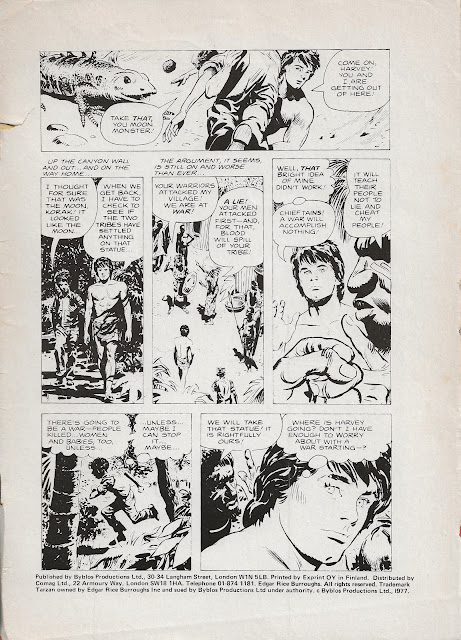Korak is the Honorable Jack Clayton, son of English Lord John Clayton, Viscount Greystoke, also known as Tarzan, lord of the jungle. He is the hero of a 1915/6 magazine serial and 1917 novel by American writer Edgar Rice Burroughs and a 1920 silent movie serial, as well as a character in several other Tarzan stories from 1914 to 1924. He experienced a revival in 1964 as the star of his own comic book series and as a major character in various Tarzan comic books, pages, and strips from 1966 to 1978.
As depicted in the comic books, pages, and strips, Korak has a lean, athletic physique, broad shoulders and thin waist, almost no clothing, a cute, boyish face, and full, thick hair. He is also an intelligent, enthusiastic teen-aged boy with excellent natural instincts and a good heart.
Korak strives to emulate his legendary father but lacks his strength, maturity and experience. Therefore, he is both more likely to enter into dangerous situations and more vulnerable to being defeated.
As the star of his own comic book series in 1964, Korak is a capable, young hero. His adventures were somewhat similar to those of his father Tarzan, but independent from them.
Previously, Korak was in captivity on a boat and wearing bandages on his head. However, with the help of a veiled red-haired woman, Korak began to remember the circumstances. The veiled red-haired woman introduces herself as Leila, priestess of the great god Krackoa, who are bred to have such allure that they are forced to wear veils to hide it. She was kidnapped by raiders and brought to a city. However, when they removed the veil, they started fighting among themselves over her. Korak fought and defeated the raiders and rescued her. However, after removing her veil, Korak immediately became obsessed with her.
The raiders discovered them in the walled garden. During the subsequent fight, Korak was injured in the head by a sword. However, the guardian priests of Krackoa manage to drive off the raiders and, at the behest of Leila, take Korak with her on the boat to the lake of Krackoa and bandage his head and tie him to a pole. The boat enters into a lake in a dormant volcano with a giant squid, who turns out to be the great god Krackoa. Leila is called to communicate with the giant squid, who strikes her, leaving her unconscious. The boat docks at an island, where everyone else disembarks and a still unconscious Leila is carried away to be treated. Korak escapes from the boat, ambushes a guardian priest, and finds Leila, still unconscious. The son of Tarzan removes her veil again, becoming obsessed with her again, and revives the priestess with his kiss. However, Krackoa is a jealous god and a very angry one too.
This week, Leila has a message from the god Krackoa but is distracted by a handsome and pouty Korak who is jealous of her dedication to her job. Meanwhile, the guardian priests are still searching for the son of Tarzan.
Korak continues his leading role in this adventure. However, the young hero turns into a pouty trophy boyfriend, whining about Leila's preoccupation with her job as priestess of the god Krackoa and not paying enough attention to him.
Manning's artwork is excellent. A pouty, whiny Korak is still incredibly handsome, with great scenes in the bedroom with the beautiful Leila. Unfortunately, his lean, athletic physique, broad shoulders and thin waist are too often seen from the side and behind, as he is too frequently turned towards Leila.
Favorite scene: panel c
Previous blog: Korak in Sunday Tarzans (12/11/1977)
This blog is intended to raise interest in and appreciation of the Edgar Rice Burroughs character Korak. To see this story in context, you may find it in Hillman's ERBzine at the following link:
This week's adventures can also be found at the following link(s):





















